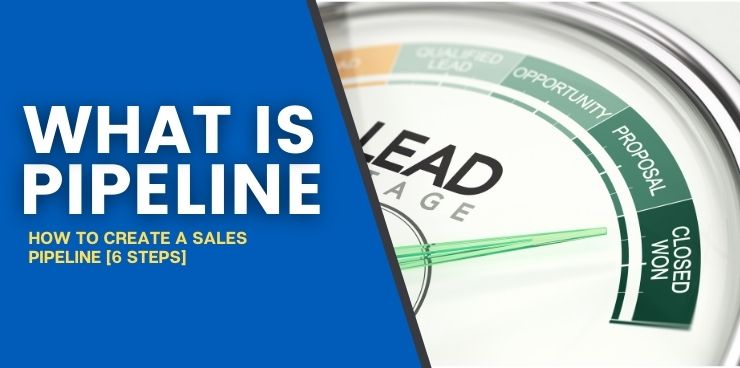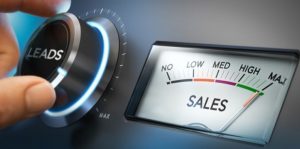The sales pipeline is the platform where we measure sales efficiency and sales effectiveness. As visual progressions of the buyer journey, pipelines indicate the various challenges and opportunities in sales cycles. For growing businesses, a well-structured sales pipeline adds consistency and predictability, allowing for continued optimization and, ultimately, more sales.
Sales team competency is closely linked to the sales pipeline, with both exerting mutual influence. A better sales team can manage the sales pipeline stages, giving it shape. Meanwhile, a strategic sales pipeline structure gives the sales rep the time, support and resources to succeed.
As the overarching concern in promoting sales quality, a focus on constructing an efficient sales pipeline is clearly beneficial. By understanding how to design and implement practical sales pipelines, your team will be empowered to handle and close more deals.
What Is a Sales Pipeline?
Similar to the sales funnel, the sales pipeline shows the progression of customers moving toward a sale. Constructed of several stages, a pipeline represents the introduction of leads, their engagement with marketing and sales and their purchase.
A sales pipeline organizes potential customers within the sales process. Sales reps can identify where prospects lie in the pipeline and take any associated actions. This helps reps to not only track deals and handle more prospects, but also increase their sales velocity.
What Is Sales Pipeline Management?
Like most sales and marketing programs, sales pipelines are part of an iterative process of tracking and improvement. Sales pipeline management is crucial in building better processes that lead to higher volumes and larger deals.
By illustrating where prospects fall within the sales cycle stages, sales managers can easily see risk and potential. Sales managers assign quotas and goals to track, providing insight into sales team weaknesses and training opportunities. Holding teams accountable allows managers to isolate and replicate positive behaviors and work individually to refine sales skills.
Sales management can also use pipelines to improve sales process steps. If they see prospects consistently getting bottlenecked at a particular stage, they will know that something needs to be adjusted. By providing training insight and highlighting process deficiencies, sales pipelines let managers establish practices that generate the most revenue.
Characteristics of Sales Pipeline Management
Sales pipeline management involves tracking and predicting results and adjusting sales activities to help the team win deals. No matter your method of managing sales in your particular pipeline, there are key concepts inherent to any scheme:
- Metrics: The data you collect on the sales pipeline to measure your sales effectiveness and efficiency at each stage. Commonly used metrics include close rate, speed-to-close, number of deals and deal size. Metrics let managers identify individual strengths and weaknesses and alleviate roadblocks in the sales process.
- Sales Forecasting: Predicting future sales and strategies to increase them. Tied to quota attainment, forecasting uses metrics to estimate the size, frequency and nature of future sales. With accurate forecasting, managers can equip sales reps with the resources they need to handle the anticipated sales volume.
- Optimization: Improving processes to increase revenue. Pipeline management requires ongoing improvement, changing to eliminate weaknesses and respond to consumer trends. Detailed analytics and educated forecasting give managers the knowledge to change practices and policies to streamline the sales process.
- Technology: Integrating new technology and applications to facilitate the sales process. New tracking, scheduling and marketing automation technology make it easier to handle big picture goals and individual needs simultaneously. Curating a workable mix of programs and applications is essential in easily formulating strategies out of data.
Sales Pipeline vs Sales Funnel
It is easy to confuse a sales pipeline with a sales or marketing funnel. After all, the funnel is a popular representation of the sales pipeline progression. However, the textbook definitions of sales pipeline versus sales funnel do carry key distinctions worth understanding.
A sales funnel shows the transition of leads to prospects, giving a look into your volume of qualified leads. It reveals how many legitimate business opportunities you have available through various stages of engagement.
The sales pipeline is where sales funnel stages and sales process intersect. The pipeline puts your wealth of prospects against the sales process steps and appropriate actions. Everything from lead generation to demos to follow-up is defined and measured in the sales pipeline.
The 6 Stages of a Sales Pipeline
Your customers, products and business structure will invariably influence how you build your sales pipeline. With that in mind, your sales pipeline should be unique, whatever works best for you and your team. Some businesses use a five-step pipeline while others feel they need seven or eight steps. However, nearly every effective sales pipeline integrates six essential stages.
Prospecting
Before you can fill a sales funnel, you have to find that lead with buying potential. Generating leads and qualifying them into prospects requires tight coordination between sales and marketing.
Marketing often leads the charge to produce material that raises awareness and generates interested leads. Content, social media and traditional advertising are used to create that visibility and value that leads to engagement. Once they have displayed a certain level of interest, leads are further segmented and turned into sales opportunities.
Sales reps mainly need to capitalize on opportunities driven by marketing, but they can generate leads as well. Reps can cold call, source leads from their CRM or support marketing channel activities through social media and email.
Qualifying
Lead qualification is critical in increasing close rates. Upon contact with a lead, salespeople need to thoroughly vet their need and ability to buy. Key questions they may need to answer include:
- Does the client have a need that can be solved with our product?
- Is the client in immediate need or actively searching for solutions?
- Does the client have the resources and budget to buy your solution?
- Is my contact the ultimate decision-maker? Can I recruit them as an internal ambassador when dealing with the decision-maker?
- What are their objections and can I confidently address them?
Answering these questions allows you to organize your cold, warm and hot leads within the pipeline. This saves time and money as you can more intelligently prioritize prospects. It also gives you room to nurture cold leads and approach them at the right opportunity.
 Contacting
Contacting
The initial contact with a prospect is the highly consequential first impression. In this step, salespeople reach out via phone, email or online chat to have a person-to-person discussion.
This is an important point that helps determine the urgency of their needs and how they fit your product. After effective sales calls, sales reps can begin assigning lead scores and organizing prospects according to their potential.
Building Relationships
Sales reps have to build relationships to inspire the trust that leads to conversion and future business. This means taking a customer-centric approach, providing information, consultation and concern based on their needs.
Selling your product is the ultimate goal, of course, but forcing a sale will likely do more harm than good. Throughout the customer experience, reps need to offer value, actively listen and engage to separate themselves from the competition. Customers need to view sales reps as indispensable partners in furthering their own success.
Closing
The hardest part of selling is asking for the sale. It takes intuition and confidence to approach the close at the right time. Customers will rarely start that conversation, so you have to ask if they are ready.
By asking for the sale, you will push the customer to reveal any underlying objections for you to address. If you can overcome their concerns and reinforce your value, you give prospects little room to say “no”.
Follow-Ups
Maintaining contact with cold leads ensures you do not leave money on the table. Maybe they were not ready to buy or were waiting on funds. Having details attached to customers based on your qualification will guide you in how and when you follow up.
Post-sale follow-up is also helpful after you have closed a sale. Customers appreciate the concern in how solutions are working and it gives them a chance to offer valuable feedback. With both cold leads and prior customers, follow-up promotes a healthy relationship.
Steps on How to Build a Sales Pipeline
Knowing the rough outline of a successful sales pipeline is essential in building your own custom model. Let’s take a step back and discuss how to find the best way to implement sales pipeline steps. The following tips will help you build a sales pipeline that fits your target market and business goals.
Step 1. Research, research, research
Research is critical in two phases: your initial market research and your list-building research. Initial market research is where you create your personas or ideal customer profiles. These are the characteristics of the customer that can and will use your solution.
List-building research takes place once you have identified viable companies to pursue. You can buy lists from lead generation companies, but these can be both expensive and outdated. Instead, find internal contacts and detail their information and agency in reaching purchase decisions. With more information, reps spend less time assessing needs and searching for decision-makers in the initial contact stage.
 Step 2. Understand the nature of your target market
Step 2. Understand the nature of your target market
Based on your research, you should be able to identify the characteristics of the most profitable customers. Armed with that description, you can pinpoint that accessible potential customer that matches those characteristics. Like the sales pipeline itself, these ideal customer profiles should continually be adjusted to fit changes in the market.
Step 3. Identify your target companies
In B2B sales, decisions are made at organizational, not individual, levels. From your research, you need to identify companies that can benefit from your solutions. Target key decision-makers within the executive levels, like CEOs or marketing executives. If you cannot reach them directly, target individuals lower down the chain and establish an internal network for leverage.
Step 4. Make contact
Contacting your clients can begin with a phone call, email, social media interaction or even a meeting. Make contact on your customer’s terms, relying on your research to guide your approach. As part of your follow-ups, reach out to contacts every 2-3 months, even if they are cooling off.
Step 5. Establish a system
The value of a sales pipeline rests primarily in the consistency and predictability of actions at each stage. Break your pipeline into small pieces, detailing your expectations (quotas), actions and deliverables at each one. Sales reps will develop better instincts, communication skills and accountability when you create a routine.
Step 6. Generate steam as you move through the process
As you stick to your pipeline process, you should be building sales momentum at each stage. Leads that are more qualified and advance at a reasonable pace are more likely to reach the end goal quickly.
Leveraging sales managers and account executives are critical with sales-qualified leads. Turning over hot prospects keeps your pipeline moving and gives discretionary deal-making to the right people.
Conclusion
The quality and care put into your sales pipeline is directly related to the revenue you generate. The pipeline directs every action that closes deals, influencing your training, sales enablement, marketing and even corporate culture. When you invest in a clearly defined pipeline, you streamline the sales cycle, building revenue and a better customer experience.
Are you struggling to develop a sensible sales pipeline? The Selling Revolution was created to help businesses implement better strategies and practices where they need them, including the sales cycle. Our sales experts work closely with our clients to identify and remedy the challenges impeding their full growth. If you would like to learn how the Selling Revolution can revitalize your sales team and fuel long-term success, book a call with our team today.


 Contacting
Contacting Step 2. Understand the nature of your target market
Step 2. Understand the nature of your target market